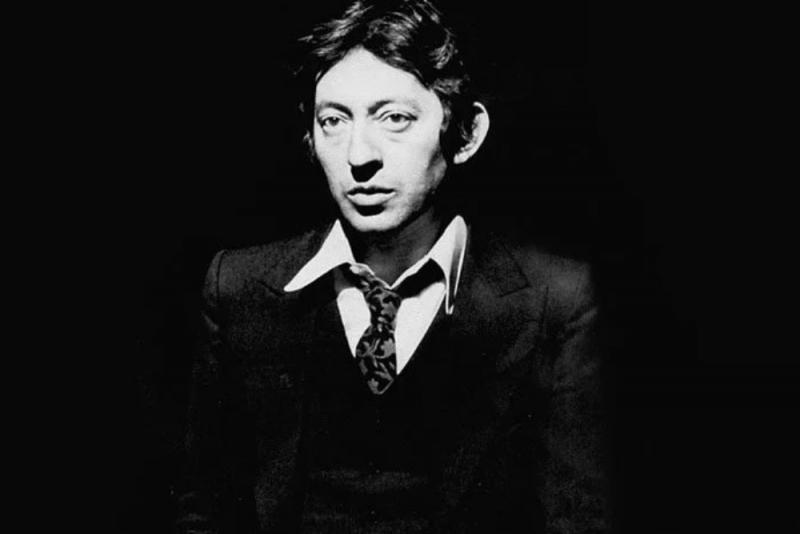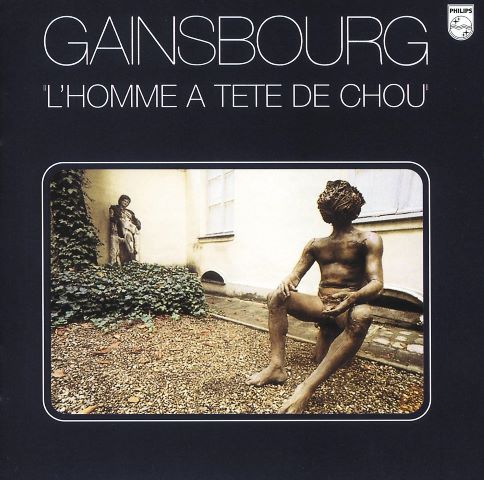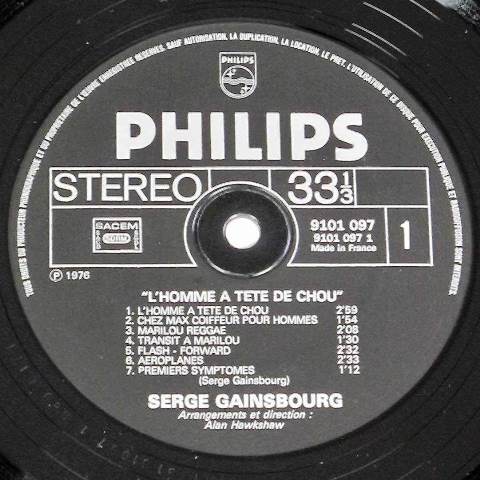Music Reissues Weekly: Serge Gainsbourg - L'Homme à tête de chou | reviews, news & interviews
Music Reissues Weekly: Serge Gainsbourg - L'Homme à tête de chou
Music Reissues Weekly: Serge Gainsbourg - L'Homme à tête de chou
Perplexing new edition of the Gallic provocateur’s 1976 concept album

Marilou lies on the ground. She’s been bludgeoned to death by a fire extinguisher. Its foam covers her body. Her murderer is a forty-something man who has become obsessed with her. She shampoos hair in a barbers, where he first comes across her. Their affair turns sour after he finds her in bed with two other men. After the murder, her killer ends up in a mental hospital.
This depraved, sordid story is told on a song-by-song basis by its provocative creator Serge Gainsbourg on his 1976 album L'Homme à tête de chou. The narrative of the album whose title translates as “the man with the cabbage head” isn’t far removed from that of his 1971 album, Histoire de Melody Nelson. L'Homme à tête de chou followed-up to 1975’s Rock Around the Bunker, a peculiar mélange of Fifties-style rock ’n’ roll and Gainsbourg’s retrospective views of being a child in the Nazi-administered France of World War II. The three albums, and 1973’s Vu de l'extérieur, were recorded in London with British session musicians – most of whom played on all four albums.
 L'Homme à tête de chou has taken longer to be embraced by the non-Gallic, non-Francophone world than Histoire de Melody Nelson and Gainsbourg’s groovy, mid-to-late Sixties records – of which his 1966 Qui Est “In” Qui Est “Out” EP included a track titled “Marilu,” the lyrics of which presaged parts of the story recounted by Histoire de Melody Nelson. The 1971 album, in turn, conceptually and musically informed L'Homme à tête de chou. Gainsbourg was an inveterate recycler. In time, L'Homme à tête de chou’s musical similarities to …Melody Nelson meant it gained a resonance beyond France. There was no need to understand the lyrics or know the story to appreciate the album.
L'Homme à tête de chou has taken longer to be embraced by the non-Gallic, non-Francophone world than Histoire de Melody Nelson and Gainsbourg’s groovy, mid-to-late Sixties records – of which his 1966 Qui Est “In” Qui Est “Out” EP included a track titled “Marilu,” the lyrics of which presaged parts of the story recounted by Histoire de Melody Nelson. The 1971 album, in turn, conceptually and musically informed L'Homme à tête de chou. Gainsbourg was an inveterate recycler. In time, L'Homme à tête de chou’s musical similarities to …Melody Nelson meant it gained a resonance beyond France. There was no need to understand the lyrics or know the story to appreciate the album.
It wasn’t only Gainsbourg’s own previous creations which fed into L'Homme à tête de chou. Part of the spur was, as she had acknowledged, his jealousy of his life partner Jane Birkin pursuing her career in film. When she was away working, he was resentful. Also, he had bought a Claude Lalanne sculpture of a man with a cabbage (the “chou”) for a head, which resonated with Gainsbourg's anxieties about his own looks. Additionally, he was aware of an inspiration for Lalanne’s work: the 16th-century Lowland artist Jan van Wechelen’s work The Legend of the Baker of Eeklo – a depiction of the tale of what happens to those who are unhappy with how they look. They may find, as the painting shows, that their head turns into a cabbage – this occurs in the lyrics of the album’s “Premiers symptômes.” And, as he had done in the past, Gainsbourg incorporated classical music into his own work: the album’s "Ma Lou Marilou" borrowed part of Beethoven's “Sonate Pour Piano n°23, Appassionata.”
In France, after its November 1976 release, the byzantine L'Homme à tête de chou has never been out of catalogue. Until 2023, the most notable reissues were a 2001 remaster for CD and another remaster only available as part of a 2011 Gainsbourg box set. In 2008, a dance interpretation was created for stage. The originator of this endeavour, Alain Bashung, recorded his own version of the album which was issued in 2011 (Bashung had died in 2009). Now, a new edition of this cultural benchmark has arrived.
 It’s immediately obvious that this new version is different to the original album. On the cover of that, the photo of the Lalanne artwork was taken from an angle so one of the sculpture's metal hands obscured its penis (pictured left). Now, in a shot from the original session, the cabbage-headed entity is seen front-on, legs splayed with an unobscured penis. There is also a sticker on the cover, saying what’s heard is a new, unreleased (“inédit”) mix of the album and that there is also an instrumental rendering of the full album, along with alternate versions of four of its tracks. Pretty enticing. The new L'Homme à tête de chou comes in various formats: double-album vinyl; CD set with a Blu-ray of a Dolby Atmos mix, a 5.1 surround mix, an HD version and the 1976 mix; a single-LP picture disc. The double-album is looked at here.
It’s immediately obvious that this new version is different to the original album. On the cover of that, the photo of the Lalanne artwork was taken from an angle so one of the sculpture's metal hands obscured its penis (pictured left). Now, in a shot from the original session, the cabbage-headed entity is seen front-on, legs splayed with an unobscured penis. There is also a sticker on the cover, saying what’s heard is a new, unreleased (“inédit”) mix of the album and that there is also an instrumental rendering of the full album, along with alternate versions of four of its tracks. Pretty enticing. The new L'Homme à tête de chou comes in various formats: double-album vinyl; CD set with a Blu-ray of a Dolby Atmos mix, a 5.1 surround mix, an HD version and the 1976 mix; a single-LP picture disc. The double-album is looked at here.
What’s now issued as “unreleased” is not a mix from 1976, but a new remix made from the multi-track album masters. The word “unreleased” as per the marketing doesn’t apply as this is not something shelved. It is new; it has been recently created for release. Seconds into listening, it becomes clear the goal is to balance the vocal and instrumental tracks. The original album's production adopted a typically and very French approach of heavily foregrounding the voice, so it and the lyrics are the focus. In 1976, Gainsbourg’s talk-singing was paramount. Now, though, there is a less obviously French feel to the overall sound as the instruments and vocals are of a piece with each other. As a result, Gainsbourg’s familiar sibilance is all-but gone. The new mix has a greater clarity and punch to what was in the shops previously. There has also clearly been a conscious decision to bring back into the mix the synthesiser parts – meaning that “Marilou reggae” has mostly lost its "Barbados" feel (the 1975 song by Typically Tropical with the deathless “Woh, I'm going to Barbados” lyrics). Listeners familiar with the album as it was will raise an eyebrow while experiencing this sonic reinvention.
The instrumental versions are a result of revisiting the multi-track tapes and not including the vocals – reels of 1976-vintage backing tracks did not exist. Recording of what became the L'Homme à tête de chou album took place from 16 to 20 August 1976 at London’s Phonogram Studio. The vocals were tracked by Gainsbourg on the last day, 20 August. The tape logs pictured in the accompanying booklet reveal that between 12 and 22 of the tracks were used at the time – there was no yen to fill all of the 24 tracks. Gainsbourg’s voice was taped on tracks 21, 22 and 23 – or one or two of these tracks. Hearing this newly created music-only version of the album is fun – some good studio chat is audible.
 Harder to figure out are what’s trailed as the four alternate versions. The short extract from “Transit à Marilou” is a different vocal take to the finished, original album and also has slightly different lyrics. “Ma Lou Marilou” has Gainsbourg reciting refrains sung by female vocalists on what was originally issued. So far, so alternate. “Meurtre à l’extincteur” is an isolated vocal track. “Lunatic Asylum” feels like a new mix teaming a vocal with percussion tracks.
Harder to figure out are what’s trailed as the four alternate versions. The short extract from “Transit à Marilou” is a different vocal take to the finished, original album and also has slightly different lyrics. “Ma Lou Marilou” has Gainsbourg reciting refrains sung by female vocalists on what was originally issued. So far, so alternate. “Meurtre à l’extincteur” is an isolated vocal track. “Lunatic Asylum” feels like a new mix teaming a vocal with percussion tracks.
Considering the trouble taken with finding an alternate photo for the cover and revisiting the multi-track masters, then transferring them on a track-by-track basis to digital and subsequently mixing them afresh, aspects of this release mystify. The original album had an inner sleeve with the lyrics – the lyrics are not reproduced in the new package. The booklet’s main essay (there is an introductory text justifying the whys and wherefores of the new mix) is extracted from the 2019 book En studio avec Serge Gainsbourg. Couldn’t fresh text have been commissioned? The records come in unlined paper inner sleeves – ensuring that as they are taken in and out they will become scratched. Bearing in mind the high-end nature and challenging price of this package (between £35 and £45 for the double LP in the UK), such seemingly cost-cutting measures are bizarre.
As to what this new L'Homme à tête de chou represents? This is not a reissue or, as the sticker puts it, “L’Edition definitive.” It is a different L'Homme à tête de chou to what the world has had since 1976. Was a new mix needed? Hardly. As an artistic choice, the original album placed the vocals to the fore. Now, they are not. It was about Gainsbourg’s lyrics. Now, it is not. What’s emerged in 2023 is unnecessary.
- Next week: Electronic Works – celebration of the electro-acoustic recordings by Finnish composer Osmo Lindeman
- More reissue reviews on theartsdesk
- Kieron Tyler’s website
Explore topics
Share this article
The future of Arts Journalism
You can stop theartsdesk.com closing!
We urgently need financing to survive. Our fundraising drive has thus far raised £49,000 but we need to reach £100,000 or we will be forced to close. Please contribute here: https://gofund.me/c3f6033d
And if you can forward this information to anyone who might assist, we’d be grateful.

Subscribe to theartsdesk.com
Thank you for continuing to read our work on theartsdesk.com. For unlimited access to every article in its entirety, including our archive of more than 15,000 pieces, we're asking for £5 per month or £40 per year. We feel it's a very good deal, and hope you do too.
To take a subscription now simply click here.
And if you're looking for that extra gift for a friend or family member, why not treat them to a theartsdesk.com gift subscription?
more New music
 Solar Eyes, Hare & Hounds, Birmingham review - local lads lay down some new tunes for a home crowd
Psychedelic indie dance music marinated in swirling dry ice
Solar Eyes, Hare & Hounds, Birmingham review - local lads lay down some new tunes for a home crowd
Psychedelic indie dance music marinated in swirling dry ice
 The Lemonheads' 'Love Chant' is a fine return to form
Evan Dando finally gets back in the saddle with an album of new tunes
The Lemonheads' 'Love Chant' is a fine return to form
Evan Dando finally gets back in the saddle with an album of new tunes
 Music Reissues Weekly: Evie Sands - I Can’t Let Go
Diligent, treasure-packed tribute to one of Sixties’ America’s great vocal stylists
Music Reissues Weekly: Evie Sands - I Can’t Let Go
Diligent, treasure-packed tribute to one of Sixties’ America’s great vocal stylists
 'Deadbeat': Tame Impala's downbeat rave-inspired latest
Fifth album from Australian project grooves but falls flat
'Deadbeat': Tame Impala's downbeat rave-inspired latest
Fifth album from Australian project grooves but falls flat
 Heartbreak and soaring beauty on Chrissie Hynde & Pals' Duets Special
The great Pretender at her most romantic and on the form of her life
Heartbreak and soaring beauty on Chrissie Hynde & Pals' Duets Special
The great Pretender at her most romantic and on the form of her life
 The Last Dinner Party's 'From the Pyre' is as enjoyable as it is over-the-top
Musically sophisticated five-piece ramp up the excesses but remain contagiously pop
The Last Dinner Party's 'From the Pyre' is as enjoyable as it is over-the-top
Musically sophisticated five-piece ramp up the excesses but remain contagiously pop
 Moroccan Gnawa comes to Manhattan with 'Saha Gnawa'
Trance and tradition meet Afrofuturism in Manhattan
Moroccan Gnawa comes to Manhattan with 'Saha Gnawa'
Trance and tradition meet Afrofuturism in Manhattan
 Soulwax’s 'All Systems Are Lying' lays down some tasty yet gritty electro-pop
Belgian dancefloor veterans return to the fray with a dark, pop-orientated sound
Soulwax’s 'All Systems Are Lying' lays down some tasty yet gritty electro-pop
Belgian dancefloor veterans return to the fray with a dark, pop-orientated sound
 Music Reissues Weekly: Marc and the Mambas - Three Black Nights Of Little Black Bites
When Marc Almond took time out from Soft Cell
Music Reissues Weekly: Marc and the Mambas - Three Black Nights Of Little Black Bites
When Marc Almond took time out from Soft Cell
 Album: Mobb Deep - Infinite
A solid tribute to a legendary history
Album: Mobb Deep - Infinite
A solid tribute to a legendary history
 Album: Boz Scaggs - Detour
Smooth and soulful standards from an old pro
Album: Boz Scaggs - Detour
Smooth and soulful standards from an old pro
 Emily A. Sprague realises a Japanese dream on 'Cloud Time'
A set of live improvisations that drift in and out of real beauty
Emily A. Sprague realises a Japanese dream on 'Cloud Time'
A set of live improvisations that drift in and out of real beauty

Add comment